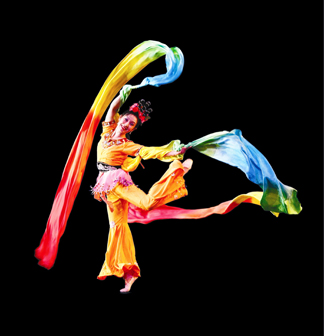Share |
Dance: What Dance Styles Say About Us
By Francine L. Trevens
ART TIMES Sept/ Oct 2011
 Nandini Sikand. (photo by Alex Beauchesne) |
The world has changed in myriad ways since my childhood during World War II. Watching some old films, and reading the biographies of those who were the big names in my day, I realized how significantly dance itself has changed: Most particularly social dancing. Thinking of how it has changed made me suddenly aware that dance reflects more than a musical trend – it also illustrates a social trend and mindset.
That dance is a basic reaction to music or a strong beat is evident in even the youngest children. Play music and they sway or hop about to it. Adults sitting in a theater or listening to music on radios or through earphones react by tapping their fingers or feet, or timing their strides with the beat of the music to which they are listening.
Ethnic dances often reflect the early influences of dance, which were a form of religious worship. They are often very stylized, with picture perfect poses and frequently with staccato rather than flowing gestures – Indian dance, traditional Japanese dances, Balinese dances are all such examples.
Then there are the ethnic dances, which are more flamboyant – such as Irish step dancing which is said to have been conceived as a political rebellion against English rule. This dance form enjoyed a strong American following at the turn of this century when brilliantly trained troupes brought their work to our attention.
Another exuberant ethnic dance is the Jewish hora, where groups of men and groups of women forming circles do a series of prescribed steps, celebrating the solidarity of this often prejudiced against group. I remember when I first saw a conga line thinking this was a linear modernization of the hora!
In the mid twentieth century, dance was elegant in the classic ballroom styles – and frenetic in the jitterbug, which my generation adored.
Most social dancing in early America was group dancing, where people would form different patterns and move from partner to partner, frequently partners were held an arms distance away. Square dancing is a more intimate and warmer version.
The waltz caused a scandal, in its day, because a man and woman danced in such proximity. The two-step, fox trot, tango and other dances emerged from this “holding pattern”.
 A traditional Chinese ribbon dance from Nai-Ni Chen Dance company photo by Carol Rosegg |
These dances were a coupling of a man and a woman. Even before gay rights became popular, it was a coupling of two men or two women in gay environs. The main factor was that it was a way of two people moving together.
It was often an expression of affection. It was a form of courting. It was sometimes a prelude to a kiss or more. It required moving together, often beautifully and elegantly, often in a wild profusion of lifts and spins. Their steps synchronized, they relied on each other, embraced each other. Today people admire and applaud these dances and dancers. Several television shows are based on the brilliance of couples dancing together.
I have a friend whose hobby is ballroom dancing. She and a partner sometimes compete with other dancers…they enjoy the experience of a couple of dancers where half the magic is how well they move together, how they manage to seem almost like two halves of one being when at their best. Their dancing shows trust in each other, knowledge of each other and a wordless communication.
I fell under the spell of ballet when I saw The Red Shoes, which still remains a favorite film of mine. It even stirred me to attempt to paint the beauty of the ballet moves.
The first ballet school was established in France in the mid 17th century. Ballet schools flourish even now, with littlest little girls and occasionally young boys eager to try the art form. Many audiences throng to ballet recitals and performances.
Today, in public, however, people often do not dance together – they dance alone midst a throng of others dancing alone. First time I saw a group of people dancing at a disco I thought of whirling dervishes!
Seeing this separate gyrating type of dance time and again, I realized it conveyed a loss: A loss of connections, a loss of duality and a loss of warmth. There may be fire and passion in one’s dancing, but it is not with another, it is an exhibition to a mass of others.
That reflects the mindset of too many people today – their isolation, their trouble bonding with others, their insularity. They are more at home with a computer screen or a cell phone or text messaging than with the actual presence of another human being.
They may fall into bed more easily and less self consciously, but do they fall into like and understanding and closeness that precedes and ultimately supersedes sex?
I believe such dancing shows the alienation of people today. It reflects the “me only” rather than merely the “me first” attitude of the previous generation.
As an audience, people of all ages respond to modern dance, athletic dance and ballet on stage, but prefer solo untouching dancing for themselves.
It makes me feel sorry for my grandkids, growing up in a world where friends are words or faces on a computer screen: Where competition is a mechanical box which challenges you to try to beat it. Where music is a pounding, incessant beat and melody is mostly lost, while lyrics are more and more repetitive and mindless.
I only hope the pendulum swings back before these youngsters grow up in an insular, single modem world.
http://writerfrancinetrevens.co
